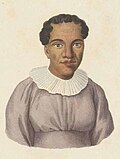

The Polynesian island of Huahine, in the Society Islands, was a kingdom ruled by the Teurura'i dynasty from the 18th century until its annexation by France in 1895. The island is now a part of French Polynesia.


The Polynesian island of Huahine, in the Society Islands, was a kingdom ruled by the Teurura'i dynasty from the 18th century until its annexation by France in 1895. The island is now a part of French Polynesia.
| Portrait | Name | Birth–Death | Reign start | Reign end | Notes |
|---|---|---|---|---|---|
| Tehaʻapapa I | 1735–1810 | 1760 | 1790 | First reign. De facto paramount ruler from 1760 to 1790. First as ariʻi rahi. | |
| Teriʻitaria I | 1769–1793 | 1790 | 1793 | Succeeded his mother Tehaʻapapa in 1790. Deposed in 1793 by his half-brother. | |
| Tenania | 1770–1814 | 1793 | 1810 | Succeeded his half-brother. | |
| Mahine Teheiura | 1761–1838 | 1810 | 1815 | Brother of Tenania. He abdicated for his niece Teriʻitaria II of Raiatea. | |
 | Teriʻitaria II | 1790–1858 | 1815 | 5 January 1852 | Deposed during a civil war on 26 December 1851 |
| Ariʻmate | 1824–1874 | 5 January 1852 | 8 July 1868 | Deposed in July 1868 during a civil war. Succeeded by his wife. | |
 | Tehaʻapapa II [1] | 1824–1893 | 8 July 1868 | 28 May 1893 | Heiress presumptive of King Tamatoa IV of Raiatea and Tahaʻa. Ruler of Huahine (1868–1893), ruled under French protectorate from 1885 to 1890. |
 | Regent Marama | 1851–1909 | 1884 | 15 September 1895 | First born son of the Huahinean sovereign, he acted as regent for his mother and his daughter from 1884 to 1895. |
| Teuhe | 1848–1891 | 22 March 1888 | 22 July 1890 | Raised to the kingdom in 1888. She reigned under a rebellion government against her mother Tehaʻapapa II. Deposed in 1890 by her brother regent Marama and exiled in Tahiti where she died one year later. | |
 | Tehaʻapapa III [1] | 1879–1917 | 28 May 1893 | 15 September 1895 | Last Queen of Huahine and Maiaʻo, France annexed Huahine and Maiaʻo on 15 September 1895. |
| ||||||||||||||||||||||||||||||||||||||||||||||||||||||||||||||||||||||||||||||||||||||||||||||||||||||||||||||||||||||||||||||||||||||||||||||||||||||||||||||||||||||||||||||||||||||||||||||||||||||||||||||||||||||||||||||||||||||||||||||||||||||||||||||||||||||||||||||||||||||||||||||||||||||||||||||||||||||||||||||||||||||||||||||||||||||||||||||||||||||||||||||||||||||||||||||||||||||||||||||||||||||||||||||||||||||||||||||||||||||||||||||||||||||||||||||||||||||||||||||||||||||||||||||||||||||||||||||||||||||||||||||||||||||||||||||||||||||||||||||||||||||||||||||||||||||||||||||||||||||||||||||||||||||||||||||||||||||||||||||||||||||||||||||||||||||||||||||||||||||||||||||||||||||||||||||||||||||||||||||||||||||||||||||||||||||||||||||||||||||||||||||||||||||||||||||||||||||||||||||||||||||||||||||||||||||||||||||||||||||||||
| Notes: Descending dotted lines denote adoptions.
| ||||||||||||||||||||||||||||||||||||||||||||||||||||||||||||||||||||||||||||||||||||||||||||||||||||||||||||||||||||||||||||||||||||||||||||||||||||||||||||||||||||||||||||||||||||||||||||||||||||||||||||||||||||||||||||||||||||||||||||||||||||||||||||||||||||||||||||||||||||||||||||||||||||||||||||||||||||||||||||||||||||||||||||||||||||||||||||||||||||||||||||||||||||||||||||||||||||||||||||||||||||||||||||||||||||||||||||||||||||||||||||||||||||||||||||||||||||||||||||||||||||||||||||||||||||||||||||||||||||||||||||||||||||||||||||||||||||||||||||||||||||||||||||||||||||||||||||||||||||||||||||||||||||||||||||||||||||||||||||||||||||||||||||||||||||||||||||||||||||||||||||||||||||||||||||||||||||||||||||||||||||||||||||||||||||||||||||||||||||||||||||||||||||||||||||||||||||||||||||||||||||||||||||||||||||||||||||||||||||||||||